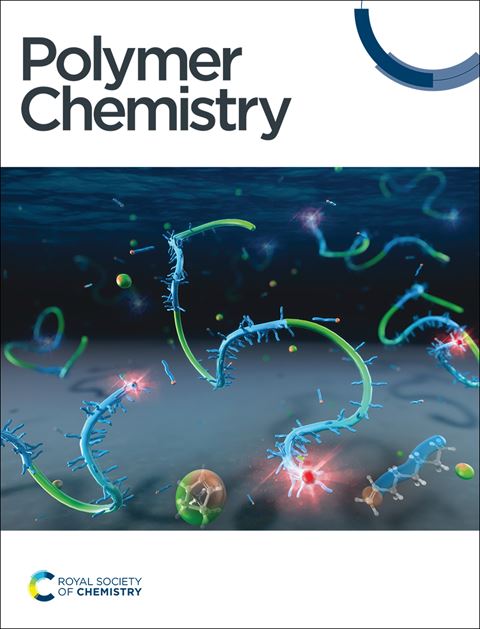A Versatile Synthetic Strategy for Non-Symmetric Isoindigo Polymers via Modular Sidechain Engineering
IF 4.1
2区 化学
Q2 POLYMER SCIENCE
引用次数: 0
Abstract
Sidechain engineering is a powerful strategy for tailoring the intrinsic properties of semiconducting polymers, enabling precise modulation of structure-property relationships critical for organic electronic applications. Breaking symmetry via sidechain engineering—by incorporating two non-identical sidechains onto the conjugated backbone—is an emerging approach to control molecular stacking and polymer chain interactions. However, the fundamental impact of sidechain induced non-symmetry remains underexplored, limiting the full tunability and optimization of this design in soft organic electronics. In this work, we investigate the structure-property relationships of isoindigo-thienothiophene-based semiconducting polymers, employing a novel “lego-like” synthetic strategy for non-symmetric condensation of alkylated precursors. This method significantly enhances specificity, customizability, and reproducibility, facilitating the development of fully tunable systems. Using this approach, we synthesized a series of non-symmetric polymers with linear and branched aliphatic sidechains to evaluate their impact on polymer packing motifs and performance in organic field-effect transistors (OFETs). Multimodal characterization revealed that these non-symmetric polymers exhibit electronic properties comparable to their symmetric counterparts while demonstrating reduced crystallinity and low Young’s moduli, as shown by atomic force microscopy. Furthermore, increasing the carbon spacer length from 1 to 4 carbons in the branched chain moiety improved charge transport, achieving average hole mobilities of up to 0.12 cm²/Vs and 0.10 cm²/Vs for P[(iITT)(C1C10C12)(C12)] and P[(iITT)(C4C10C12)(C12)], respectively. Overall, this work establishes a straightforward and highly tunable approach for designing a library of non-symmetric isoindigo derivatives through sidechain engineering, providing precise control over nanoscale polymer structures in thin films and unlocks new pathways for enhancing the performance of organic electronic materials.基于模侧链工程的非对称等靛蓝聚合物多用途合成策略
侧链工程是一种强大的策略,用于定制半导体聚合物的固有特性,实现对有机电子应用至关重要的结构-性能关系的精确调制。侧链工程是一种控制分子堆积和聚合物链相互作用的新方法,通过在共轭骨架上加入两条不相同的侧链来打破对称。然而,侧链引起的不对称的基本影响仍然没有得到充分的研究,限制了这种设计在软有机电子中的完全可调性和优化。在这项工作中,我们研究了异靛蓝噻吩基半导体聚合物的结构-性能关系,采用了一种新的“乐高”合成策略,用于烷基化前体的非对称缩合。该方法显著提高了特异性、可定制性和可重复性,促进了完全可调系统的开发。利用这种方法,我们合成了一系列具有线性和支链脂肪侧链的非对称聚合物,以评估它们对有机场效应晶体管(ofet)中聚合物封装基序和性能的影响。多模态表征表明,这些非对称聚合物具有与对称聚合物相当的电子特性,同时显示出原子力显微镜显示的结晶度降低和低杨氏模量。此外,将支链片段中的碳间隔长度从1个碳增加到4个碳,可以改善电荷输运,P[(iITT)(C1C10C12)(C12)]和P[(iITT)(C4C10C12)(C12)]的平均空穴迁移率分别高达0.12 cm²/Vs和0.10 cm²/Vs。总的来说,这项工作通过侧链工程为设计非对称等靛蓝衍生物库建立了一种简单而高度可调的方法,提供了对薄膜中纳米级聚合物结构的精确控制,并为提高有机电子材料的性能开辟了新的途径。
本文章由计算机程序翻译,如有差异,请以英文原文为准。
求助全文
约1分钟内获得全文
求助全文
来源期刊

Polymer Chemistry
POLYMER SCIENCE-
CiteScore
8.60
自引率
8.70%
发文量
535
审稿时长
1.7 months
期刊介绍:
Polymer Chemistry welcomes submissions in all areas of polymer science that have a strong focus on macromolecular chemistry. Manuscripts may cover a broad range of fields, yet no direct application focus is required.
 求助内容:
求助内容: 应助结果提醒方式:
应助结果提醒方式:


